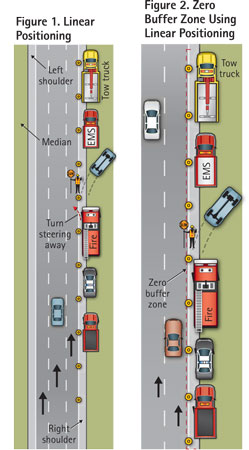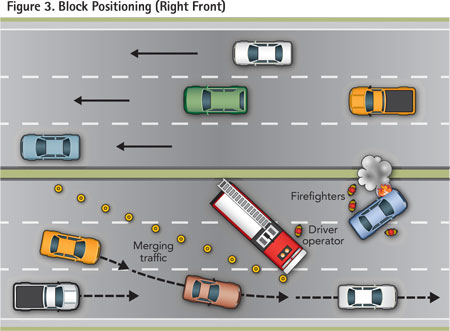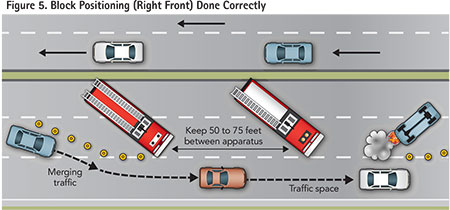
By Chad Szeklinski
Year after year, the fire service responds to hundreds of thousands of vehicle incidents on our nation’s roadway/highway systems that cause numerous injuries and deaths to civilians and firefighters. It is true that incident commanders have numerous objectives to consider, but so do drivers. Fire service personnel are becoming collateral damage. One way for drivers to prevent injury and death to their fellow firefighters is to position the apparatus correctly.
Another factor is training. Fire departments should have in place a vehicle operations training program and strong policies on driving and positioning. If your department does not have them, talk to a neighboring department that would be willing to provide information to help you develop a policy for your department. Also, have a good working relationship with your local police department. Many times, the police are the first on scene. In some jurisdictions, police/fire may not have had enough training or possibly no training when it comes to roadway safety or correct positioning. Work together!

Seven Factors to Consider
The fire apparatus driver has to take into account many factors, including the following:
- Location of incident. Most drivers take pride in knowing their service areas well. Develop a habit of learning your district’s addresses/roadways. When the call comes in, you will have a general idea of the layout of the area and the fastest, most appropriate way there. Consider whether your incident is a main thoroughfare or a narrow side street. Think about how to position ahead of time.
- The number of vehicles involved. On arrival, do you need to close the whole road with the apparatus or follow the rule of thumb of the incident lane plus one lane?
- Geography. Be aware of the terrain of the incident’s location. It is best to block at the top of the hill. Use traffic cones to close off the bottom of the hill. Do not forget to wear your safety vest when working in the streets as long as the vehicle is not on fire. Otherwise, wear full personal protective equipment. It will make you more visible to other drivers. Be aware that flammable liquids leaking from a wreck could ignite or vehicle braking systems could release if positioned downhill from an incident, sending the incident into your apparatus.
- Speed of oncoming traffic. The speed of oncoming traffic establishes the number of feet needed as a safety zone distance. The faster the traffic upstream of the incident, the more distance you will need between the apparatus and the incident. Remember, be mindful not to allow too much distance between the apparatus and the victim’s vehicle because a distracted driver could find his way in between your apparatus and the incident. It may be appropriate to have a second emergency vehicle to block farther upstream to provide direction and slow down traffic even before it reaches your location.
- Weather conditions. They play an important role in determining the stopping distance for you and civilian drivers. Remember, if the roadway is wet, the longer the stopping distance.
- Time of day. I work in an urban city where time of day can determine the direction I take to an incident because of traffic conditions. Consider the state of mind of drivers at that time. Did they just get out of work and want nothing more than to get home?
- Do I stay upstream or downstream of the incident? Drivers picture a roadway as if it were a river. Upstream is considered stopping short of the incident (the best position to protect yourself from oncoming traffic). Downstream is pulling past the incident. Upstream is the preferred apparatus positioning. Downstream is a perfect area for staging of emergency medical services (EMS) and the tow company. Intersections are most difficult to control; consider additional units if they are needed to block from more than one direction and upgrading the police response for traffic control. Do not be afraid to mention ideas to the boss.
Size-Up on Arrival
The driver needs to perform a window size-up while en route and on arrival. Sizing up a roadway incident starts with slowing down, which allows your mind to catch up with your actions. Use the above factors to help determine the ideal positioning of the apparatus.
A technique I learned in a motorcycle safety course is to use the acronym SEE, which stands for Search, Evaluate, and Execute. This technique can be used while responding: Search for potential trouble ahead, from the side, or from behind. (How fast is traffic moving?) Evaluate means to come up with a plan of action to negate the trouble. Play a game of “what if,” develop a plan, take in what your eyes are scanning, and put it all together (How am I going to position my apparatus?). Finally, Execute. Put the plan into action (I am going to use block positioning to protect my crew). This technique helps to keep the crew and patient safe. Operational success depends on correct positioning to keep you safe.
Positioning
There are two types of positioning: linear and block.
Linear Positioning
Although it is not the preferred method, linear positioning is commonly used for a single-apparatus response for an incident off to the side of the road (Figure 1). In this type of positioning, all vehicles at the incident, including the apparatus, are in a straight line. Personnel must be extremely cautious because the street side is exposed to traffic. For the purpose of this article, the street side of the apparatus is considered the driver’s side; curbside of the apparatus is considered the boss’s side. Remember, the driver’s goal is to create a safety barrier between emergency personnel and traffic. Linear positioning provides no safety for responders from the street side (Figure 1). I prefer that linear blocking not be used.

In all types of positioning, the position of the apparatus steering wheel is extremely important. Once positioned correctly for the linear position, turn the steering away from the incident. For linear positioning, if the apparatus is struck from behind by a distracted driver, the apparatus would create more friction with the roadway and be pushed away from the incident. In linear positioning, the driver side of the apparatus is the zero buffer zone; that is the reason this type of positioning isn’t preferred. A zero buffer zone (Figure 2) refers to an area where our members could be harmed or even killed. If staffing allows, assign a person as a scene safety officer to watch over members using the street side to obtain equipment. In Figure 1, notice the location of EMS and towing. They are downstream of the incident. This is key for drivers to remember: Use our apparatus (the heaviest units) as the protector by simply angling out, taking a lane if necessary, to provide protection to the street side zero buffer zone. Police may not like this, but our safety comes first.
Block Positioning
This is the preferred method of positioning and the safest. Block positioning uses our heavy apparatus as the barrier and takes the incident lane plus one lane, eliminating the zero buffer zone. Drivers must remember that with this type of positioning, they must complete a window size-up on arrival to determine the proper position. The key is to provide a barrier between your company and oncoming traffic, creating a safety zone for people working the incident.

There are two types of block positioning, right front (Figure 3), and left front (Figure 4). What does this mean? If you picture a driver sitting in the driver seat of the apparatus, left front would be considered the left bumper of the apparatus (driver side) or (street side). The company officer’s side bumper would be considered right front (boss’s side or curbside). Knowing the difference between left front and right front is important. If, for instance, you respond for a vehicle fire, right-front positioning would be appropriate for shielding yourself from oncoming traffic at the pump panel and protecting the company battling the fire at the same time (Figure 3). If the vehicle on fire in Figure 3 was on the right side of the roadway, right front is still the most appropriate positioning because the driver is protected along with the crew. Your second-due apparatus could position left front behind your apparatus to indicate the direction in which drivers should go.
Notice how the apparatus in Figures 3 and 4 is acting as a directional to traffic coming from upstream. Not only does it point the civilian drivers to the correct direction, but it also slows them down. Secondary emergency vehicles can begin the procedure of step blocking upstream of the incident. As noted, leave no more than 50 to 75 feet between emergency vehicles. Spacing farther apart could cause the distracted driver to return too soon to the lane being protected and cause an accident.
Things to Remember
Maintain a good working relationship with the men and women in blue. The police many times are on scene first. It’s a good idea for department heads that work together often to have a meeting so that standard operating guidelines/procedures (SOGs/SOPs) are on the same page. Have the police step block position farther upstream so that drivers are slowed and you have room to position the heavy apparatus accordingly. For fire and EMS agencies that have multiple apparatus/vehicles responding, give primary consideration (room) without compromising the safety of the apparatus being used to mitigate the scene – i.e., truck or extrication vehicle, for example. Get into the habit of staggering apparatus accordingly: stage EMS and towing downstream.
We are working upstream at incidents, meaning that traffic is coming at us! Remember that your safety and the safety of the crew are first priorities. If you are not wearing turnout gear, make sure you have on your Department of Transportation reflective vest. When staggering farther upstream of an incident, use block positioning – remember to keep no more than 50 to 75 feet between apparatus. Additional space would allow a distracted driver access into the closed lane, which could have deadly consequences. The apparatus farther upstream will act as an arrow to push traffic away from your incident, forcing traffic to slow and increasing the awareness of civilian drivers.

As already noted, do a proper window size-up on arrival. Skipping this step could lead to incorrect positioning and possible disaster. Many thoughts are going through a driver’s head during a response. If the drivers’ minds are going too fast, more than likely they will be driving too fast also and possibly not thinking clearly. Take a deep breath; slow things down so you can make correct decisions. Keep in mind during your size-up the considerations and SEE technique mentioned above. The incident will determine the number of lanes that need closing and the additional resources needed. Size, location, and time of day determine how congested an area will be and if space should be added to the safety zone. There is nothing wrong with having an additional unit farther upstream (step blocking) in a left-front blocking position to act as an arrow to push traffic away from the scene (Figure 5).
Particularly in the past few years, distracted or careless drivers have caused numerous firefighter deaths on our roadways/highways. Numerous “D” drivers – drugged, drowsy, distracted, and drunk – are on the roadways. One way driver operators can help protect fellow firefighters and themselves is to continue to learn about proper positioning. There are many articles on positioning in fire service journals; reading them would be a good first step in our education.
Chad Szeklinski is a heavy equipment operator and a 21-year member of the Milwaukee (WI) Fire Department (MFD), where he is assigned to Tower 2 in Downtown Milwaukee. He is a member of the Incident Command Post Team and has state certifications as a fire instructor, company officer, hazmat technician, driver operator engine and aerial, and emergency medical technician. He is an instructor for the MFD’s state driver operator state exam and has a certificate in automotive technology from Milwaukee Area Technical College.
Positioning Apparatus for Maximum Efficiency and Safety
PROPER POSITIONING OF APPARATUS
Firefighter Training Drill: Outside-the-Box Apparatus Positioning
Fire Engineering Archives

